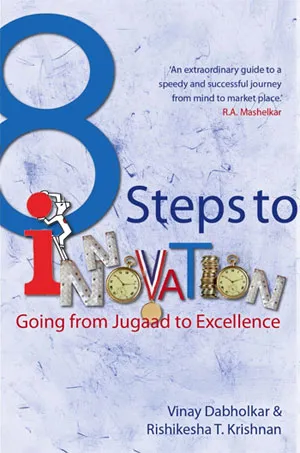[Book Review] 8 Steps to Innovation: Going from Jugaad to Excellence

2013 Harper Collins India
9 chapters, 306 pages
This book is a welcome addition to the burgeoning literature on innovation, with examples drawn from the US, Europe and especially India (see my list of book reviews of titles such as The Innovator’s DNA, India Inside and China Fast Forward). Most of the case studies are about large organisations, but there are good examples of innovative startups as well. Examples are drawn not just from the usual list of product MNCs but services firms and government agencies as well (including Tihar Jail!). The book has a companion Web site with links to useful articles and blogs for each chapter.
Vinay Dabholkar is the president of Catalign Innovation Consulting and helps organisations foster a culture of innovation. He has worked with several organisations in India over half a decade to develop the idea pipeline and the innovation leadership pipeline. He has worked with technology companies such as Motorola and Sasken, and is an active blogger.
Rishikesha T. Krishnan is a professor at the Indian Institute of Management, Bangalore, where he teaches innovation management and strategy. His earlier book, From Jugaad to Innovation, identified the challenges faced by India in enhancing industrial innovation, and how these can be overcome. He has worked with NASSCOM and CII on innovation initiatives. His blog tracks contemporary trends in innovation.
“Jugaad is old hat. It has done little for India in terms of innovation,” according to the authors.
Interestingly, there is another school of research which strongly advocates blending some principles of jugaad and frugal innovation along with structured innovation (eg. see my review of the book ‘Jugaad Innovation’ and my interview with one of the authors Navi Radjou). Perhaps I should put together a ‘grand unified theory of innovation’ with four phases: Basic Jugaad, Advanced Jugaad, Basic Structured Innovation and Advanced Blended Innovation? But that is getting ahead of the story a bit... :-)
“In today’s globalised market place it is increasingly difficult to survive with just quick fixes or creative improvisation,” Dabholkar and Krishnan advise. The authors build on a range of existing theories of innovation, international case studies, and local research and blend them into an eight-step flow of innovation capability.
The material in the book is thoroughly referenced and well structured. Each chapter begins with an inspirational quote and ends with takeaways, things to measure, things to do, and experiments to conduct. The concluding chapter ties all the material together succinctly.
Innovation has three elements, the authors explain: an idea, implementation and impact. They typically focus on a product/service/process, customer experience (eg. new store layouts) and business model (eg. IPL, Aravind Eye Hospital). A product may be new to a company but not to the market. Not every invention results in an innovation taken to market; and not every innovation is associated with an invention.
Innovation is driven by curiosity and creativity; it is an iterative process involving risk taking along with risk assessment and mitigation. Typical impediments to innovation include attitudes of ‘not invented here’ syndrome, preservation of status quo, and prediction disability.
I have summarised some of the steps and components in Table 1, but each chapter makes for a good read with insights and debates.
Table 1: Three Phases and Eight Steps to Systematic Innovation
Startups will particularly find Chapter 6 useful, which addresses business model iteration (also see the book review of Lean Startup by Eric Ries). It shows how, for example, Anupam Mittal tweaked the model of online matrimonials site Shaadi.com to offer physical centres across India for offering services to parents of partners and not just the couples (eg. wedding planning).
RedBus founder Phani Sama first thought of selling software to bus operators – but then decided to offer ticket sales. Micromax began by providing software services for Nokia and Airtel, and then sold phones targeting market gaps such as dual-SIM phones and long-life batteries. TCS now targets SMEs through its iON cloud service. Software product companies embrace services once their product matures, and vice versa.
The concluding chapter offers ideas on how innovation leaders may create ‘innovation management dashboards’ to track innovation flows and successes, and nurture innovation cultures in the long run. Innovation can be headed by the CTO, CMO, CIO, or heads of functions such as HR or strategy.
In sum, this book definitely belongs in the hands of organisational leaders and entrepreneurs interested in the long term implications of innovation programmes, and provides useful tables and checklists for implementing their own initiatives. The wealth of case studies, anecdotes and personality profiles makes the material easily accessible to a broad audience.
It would be fitting to end this book review with some of the featured quotes:
“Once your mind stretches to a new level, it never goes back to its original dimension.” – A.P.J. Abdul Kalam
“Learn to fail with pride, comfort and pleasure.” – Nassim Nicholas Taleb
“The theory of business has to be tested continuously.” – Peter Drucker
“I can calculate the motions of the heavenly bodies, but not the madness of people.” – Isaac Newton
“A journey of thousand miles begins with a single step.” – Lao Tsu
“Without computer clubs there would probably be no Apple computers.” – Stephen Wozniak
[Follow YourStory's research director Madanmohan Rao on Twitter]


![[Book Review] 8 Steps to Innovation: Going from Jugaad to Excellence](https://images.yourstory.com/cs/wordpress/2013/04/8steps.jpg?mode=crop&crop=faces&ar=16%3A9&format=auto&w=1920&q=75)




